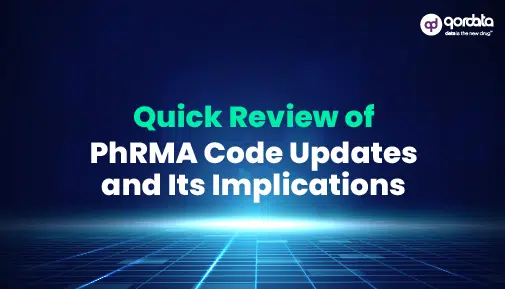Table of Contents
ToggleProviding critical insights into diseases, manufacturing innovative pharmaceuticals and medical devices, publishing research related to medical conditions, and improving overall human health are some of the core functions of the life science sector.
Keeping the life-science industry focused on its core functions is extremely important. And this means that the life-science industry must rethink one specific time-consuming process, “aggregate spend reporting.”
Aggregate spend reporting is a complicated task that requires HCPs and Os to submit transparency reports exhibiting information regarding direct or indirect payments or transfer of value (ToV) made to physicians, third parties, etc.
According to a report, in 2019 alone, $2 billion was received by physicians in general payments, and more than $71.5 million was spent on research payments.
Recording such a massive amount of data, compiling it into a transparency report, and then submitting it on time with the technicalities involved happens to be a daunting task for life-science companies and compliance officers.
This is precisely why today we’re uncovering the top 5 strategies businesses can implement in 2022 to eliminate conventional aggregate spend reporting challenges and ensure a smooth and efficient process.
An Overview of Aggregate Spend Reporting
Aggregate spend reporting is a process used in the United States to monitor, control, and make the overall amount spent on healthcare professionals and organizations transparent.
Reportable details required in the transparency report are third-party payments, physician spent, form and nature of payment, drug or device information, honoraria, and the list goes on.
Additionally, when a transparency report is prepared, it is improbable that it will end up being error-free, mainly because of the technicalities involved.
This exposes an organization to the risk of being non-compliant, which generally results in being penalized. The penalty imposed can range from $10,000 to $100,000.
From the information given above, you can gauge the complexities involved in aggregate spend reporting and why it generally takes days or even months for the compliance team of a life-science company to prepare and submit the federal reports on time.
But what if you could strategically resolve aggregate spend challenges in your organization to meet your compliance requirements every time – Well, let’s explore how you can do that.
5 Strategic Ways to Overcome Aggregate Spend Reporting Challenges
In the world of life science, where companies have to monitor hundreds and thousands of HCPs regularly to track, manage, sort, and store data for aggregate spend reporting, continually upgrading the process or approach is the key to success.
So here are five strategic ways through which most of the work required while preparing transparency reports can be modernized, automated, mitigated, and, in the long run, eliminated.
Let’s unravel the five steps to help you stay ahead of the curve and ensure that your federal reports are prepared and submitted on time.
1. Transparency Reporting Software
The #1 spot goes to getting a Transparency reporting solution that will address all your aggregate spend reporting challenges and assist your compliance professionals in preparing bullet-proof reports on time.
Since keeping up with the ever-evolving compliance requirements, changing federal laws, and tight deadlines can be daunting – it’s better to have an aggregate spend reporting platform equipped with all the tools, features, data, and options that enable you to prepare your federal reports.
Another imperative reason for getting software is that manually ensuring the quality and accuracy of a transparency report is a challenge.
To tackle the risk mentioned above, a data-driven compliance solution has specific algorithms designed to help you identify duplications and physician matching, prepare your reports for CMS, and strengthen your overall spend reporting process.
In addition, Transparency reporting platforms are regularly updated to abide by the latest federal and state laws and offer robust functionality.
This means that you’ll be able to meet your compliance objective consecutively with reporting software.
2. Process Standardization
The HCP data collection process is yet another factor that plays a critical role in your aggregate spend reporting task.
The goal here is to make the entire data collection process refined and continually improved.
From data acquiring to reporting to validating and approving, every step needs to be refined to improve efficiency and data quality.
Once completed, you will observe valuable data being collected and passed on to the compliance team, shortening the time required to prepare aggregate spend reports.
3. Cross-Functional Collaboration
Strategizing through the cross-functional collaboration of internal teams is the way forward for modern life science companies.
Through cross-functional collaborations, you can get different teams and departments operating within your organization on the same page and contribute to the conventional aggregate spend reporting challenges by providing insights.
However, it would be best if you made sure that the teams linked with the aggregate spend, i.e., Clinical operations, Transparency, Commercial Ops, and other integral departments, are involved.
4. Reinventing Spend Capture
See if manual processes for spend capture are in action in your organization. For example, if the users are entering HPC names, license numbers, and other critical details by hand – it’s time to reinvent your spend capture process.
Manually entering this data increases the risk of errors.
In contrast, an integrated data-driven solution that automatically checks for inaccuracies or duplications while eliminating the need for manual data entry will speed up the process by quickly capturing and validating comprehensive HCP and spend data required transparency reporting.
5. Managing Your Data
Data management and validation is yet another aspect that needs to be revisited, and to do that; you need to conduct meetings with your data management team.
Ask the team about the information they generally extract about PAs and APRNs. See if the information validation process is quick and seamless.
In addition to that, consider getting software that allows you to obtain information directly from the state licensing board.
Wrap Up
The five strategic steps mentioned in this article result from research conducted to understand the intricacies of aggregate spend reporting. Therefore, capitalizing on these strategic initiatives will mitigate complex spend reporting challenges while allowing compliance professionals to extract value from their organization’s spend data.
By going through each one of them comprehensively, you’ll be able to streamline your transparency reporting process and ultimately meet your compliance objective over time. Through in-depth analysis of the pointers, you’ll discover new opportunities that’ll help you future-proof your aggregate spend reporting process and bring all the data together for compliant aggregate spend reporting.









